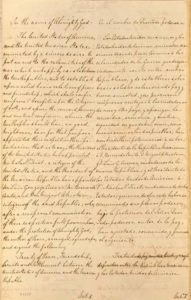Lawyers have the coolest language.
Consider the doctrine of prior appropriation. “Beneficial use,” the drafters of the New Mexico constitution explained, “shall be the basis, the measure and the limit of the right to the use of water.” It felt like poetry the first time I heard the New Mexico state engineer roll it out pit-a-pat, legal poetry, crisp and to the point. This is language that is doing real work, not just idle words, but language that is, to borrow from the field of legal geography, quite literally shaping the landscape. As with the best poetry, it says much, but also leaves us a trail of ambiguity as well. “I have seen the best minds of my generation….”
And so we have my new favorite legalism – “springing condition subsequent”.

Treaty of Guadalupe Hidalgo
I first heard this late at night last December in a Las Vegas bar, discussing the trick needed to sign a deal with Mexico over the Colorado River. The deal needed to go hand-in-hand with a parallel deal among U.S. states involving handling shortages and surpluses, and it was a chicken-and-egg problem. Each part – the international agreement with Mexico, the internal deal within the US – depended on the other to succeed.
Whichever went first had to be written in such a way that it was contingent on the approval of the other. As I wrote Tuesday, it looks like the Mexico agreement will go first, and is now very close to ready. It will take the form of a “minute”, tacked onto the 1944 U.S.-Mexico treaty governing the sharing of the Colorado River. And it concludes language that has been variously described as “contingent” or a “trigger” – a mechanism by which some of the terms of the deal only when certain conditions are met – in this case the subsequent approval of the parallel deal within the United States.
And that parallel deal? Let it be known as the “springing condition subsequent”.
